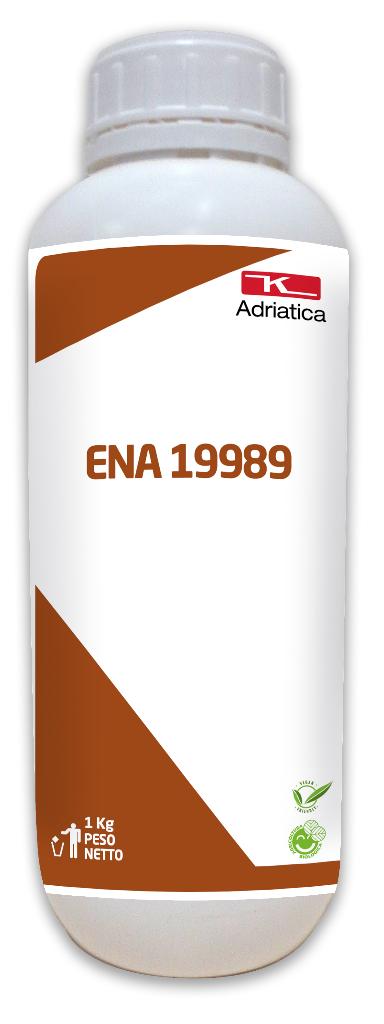

Packaging 1 kg
PHYSIOLOGICAL ACTIVATORS
ENA 19989
STIMULATES PLANT GROWTH
PROMOTES FLOWERING
IMPROVES FRUIT SET
ALLOWED IN ORGANIC FARMING
ENA 19989 is a bioactivator made of natural compounds that stimulate plants energy metabolism, with beneficial effects on all growth processes.
The AATC (N-acetyl-thiazolidine-4-carboxilic acid) content in the product in particular increases the amount of proline (an important counter-stress molecule) and cysteine (an efficient metabolic activator) in the plant tissues. This triggers the use of all plants' biochemical supplies, stimulating vital processes and helping to overcome critical development phases Throughout the whole crop cycle. Iron, molybdenum and most notably zinc are present in the formula. Iron and molybdenum influence the photosynthetic process and nitrogen's absorption respectively, while zinc enhances cellular growth and division. Ascophyllum nodosum seaweed derived alginates, carbohydrates and amino acids make ENA 19989 a formulation with a strong anti-stress activity.
When regularly applied from the early phases of the crop cycle, ENA 19989 facilitates a uniform sprouting, tissue elongation, abundant flowering and fruit set and a balanced fruit development. Thanks to its stimulating activity on cellular division and multiplication, ENA 19989 applications favour rachis' elongation on compacted bunch grape varieties.
| Culture | Time of application | Dose/hectare* |
|---|---|---|
| Grapes | From inflorescence clearly visible to post-fruit set 2-3 applications every 10-15 days |
0,5-1Kg
|
| Kiwifruit | From pre-flowering to fruit about 20% of final size 2-3 applications every 10-15 days |
0,5-1Kg
|
| Stone fruits (Plum, Peach, Nectarine, Cherry), Pome fruits (Pear, Apple, Quince) e | From pre-flowering to fruit diameter up to 40 mm 3-4 applications every 10-12 days |
0,5-1Kg
|
| Olive e Citrus (Tangerine, Lemon, Clementine, Bergamot, Orange) | From vegetative restart to fruit enlargement 3-4 applications every 10-12 days |
1Kg
|
| Hazelnut e Walnut | From vegetative restart to fruit enlargement 3-4 applications every 10-12 days |
0,5-1Kg
|
| Strawberries | At post-transplanting, pre-flowering, flowering and post-fruit set |
0,5-1Kg
|
| Fruiting vegetables (Watermelon, Pumpkin, Zucchini, Tomato, Pepper, Melon, Eggplant, Cucumber) | From post-transplanting to flowering-fruit set 2-3 applications every 10-15 days. |
0,5-1Kg
|
| Leafy vegetables (Spinach, Celery, Escarole, Rocket, Radicchio, Lettuce, Chicory) | From post-transplanting or post-emergence 2-3 applications every 8-10 days |
0,5-1Kg
|
| Artichoke | From the emission of the flower heads 2-3 applications every 8-10 days |
0,5-1Kg
|
| Flowers and ornamentals | At transplanting and pre-flowering |
0,5-1Kg
|
-
Grapes0,5-1KgFrom inflorescence clearly visible to post-fruit set 2-3 applications every 10-15 days
-
Kiwifruit0,5-1KgFrom pre-flowering to fruit about 20% of final size 2-3 applications every 10-15 days
-
Stone fruits (Plum, Peach, Nectarine, Cherry), Pome fruits (Pear, Apple, Quince) e0,5-1KgFrom pre-flowering to fruit diameter up to 40 mm 3-4 applications every 10-12 days
-
Olive e Citrus (Tangerine, Lemon, Clementine, Bergamot, Orange)1KgFrom vegetative restart to fruit enlargement 3-4 applications every 10-12 days
-
Hazelnut e Walnut0,5-1KgFrom vegetative restart to fruit enlargement 3-4 applications every 10-12 days
-
Strawberries0,5-1KgAt post-transplanting, pre-flowering, flowering and post-fruit set
-
Fruiting vegetables (Watermelon, Pumpkin, Zucchini, Tomato, Pepper, Melon, Eggplant, Cucumber)0,5-1KgFrom post-transplanting to flowering-fruit set 2-3 applications every 10-15 days.
-
Leafy vegetables (Spinach, Celery, Escarole, Rocket, Radicchio, Lettuce, Chicory)0,5-1KgFrom post-transplanting or post-emergence 2-3 applications every 8-10 days
-
Artichoke0,5-1KgFrom the emission of the flower heads 2-3 applications every 8-10 days
-
Flowers and ornamentals0,5-1KgAt transplanting and pre-flowering
-
 Foliar fertilization
Foliar fertilization






